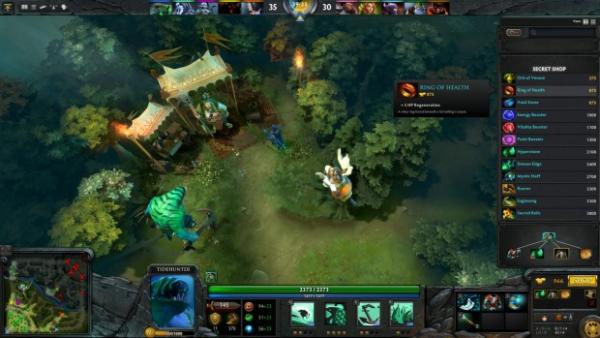Review: DotA 2

It's hard to classify Defense of the Ancients 2, a free-to-play game from Valve. It's part RPG, part RTS, part multiplayer shooter, part lots of things. This month, there were 5.2 million unique players.
The best I can describe it, is if you've ever played a traditional RTS, and recall one of the "hero" levels where you play as just one, uber-strong, character. That's DotA. Sort of. It can be pretty intense, and quite fun, too.
If you keep reading I promise no more unexplained abbreviations.
As you can see from the image above, DotA takes an isometric view of the battlefield, which itself is a fairly simple affair with three main lanes between two bases, one in each corner. The goal is to destroy the enemy's guard towers, on your way to destroying their base, while at the same time protecting your own towers and base.
Assisting you are three other teammates (either players or the computer), and a horde of peons controlled by the AI that act as cannon fodder.
This simple premise belies the complexity of the game, and where a lot of the fun comes in. You can choose from over 100 different characters, each with different special powers, looks, and voiceovers (the latter being varied and excellent). The choices, at first, are rather daunting. One way to make it easier is by narrowing these characters down into more mentally manageable chunks. For example, if you want to play as a tank-like physical bruiser, you can find a bunch of those. More of a stand-off glass-cannon caster? Bunch of those too. While these dictate part of the playstyle, this isn't the entire story either.
The beginning of each game (which can last an hour or so), is generally just killing peons, occasional lucky hits on an enemy players, and overall just gaining money and skill points. At the start of each round, everyone is a level 1 weakling, with just a few special pieces of equipment. As you gain levels, new and more powerful spells are unlocked, and you get money to buy better pieces of gear (which themselves augment your avatar).
Certain characters are better at certain things, and for a team to win, a mixture of types is crucial. For example, certain characters are good at area-of-effect attacks, doing small amounts of damage to a large group of enemies. Some are good at the opposite: lots of damage to single enemies. Some start out fairly weak, but get much, much more powerful as they gain level.
If this whole thing seems daunting, well, you're right. If one was expected to jump in playing with all of these variables, most people would never get to a second round. Valve is smarter than that, though. When you first begin the game, you're shepherded through a series of increasingly complex tutorials that culminate with you playing full games against the computer, and/or against some other noobs.
Then, you can either play out in the wild with real people, or just set up matches against the computer until you're at a point where you won't embarrass yourself. You will embarrass yourself, lets be clear, it just won't be an outright slaughter if you practice first. Playing against the computer is also a good way to learn a wide varity of characters, in case your first choice is taken by another player in a "real" match.
And the matches can get rather frenetic. Landing kills on enemy players is very satisfying. Winning, after a concerted effort, is awesome.
If, for whatever reason, you like the idea of DotA 2, but not exactly DotA 2, there's always League of Legends, which was inspired by the original DotA, a mod for Warcraft III.
Bottom Line
Starting with a simple premise, the layers upon layers of complexity make DotA 2 challenging and fun.
It's also free. So, I'm not sure why you're still reading...
- Log in or register to post comments































































